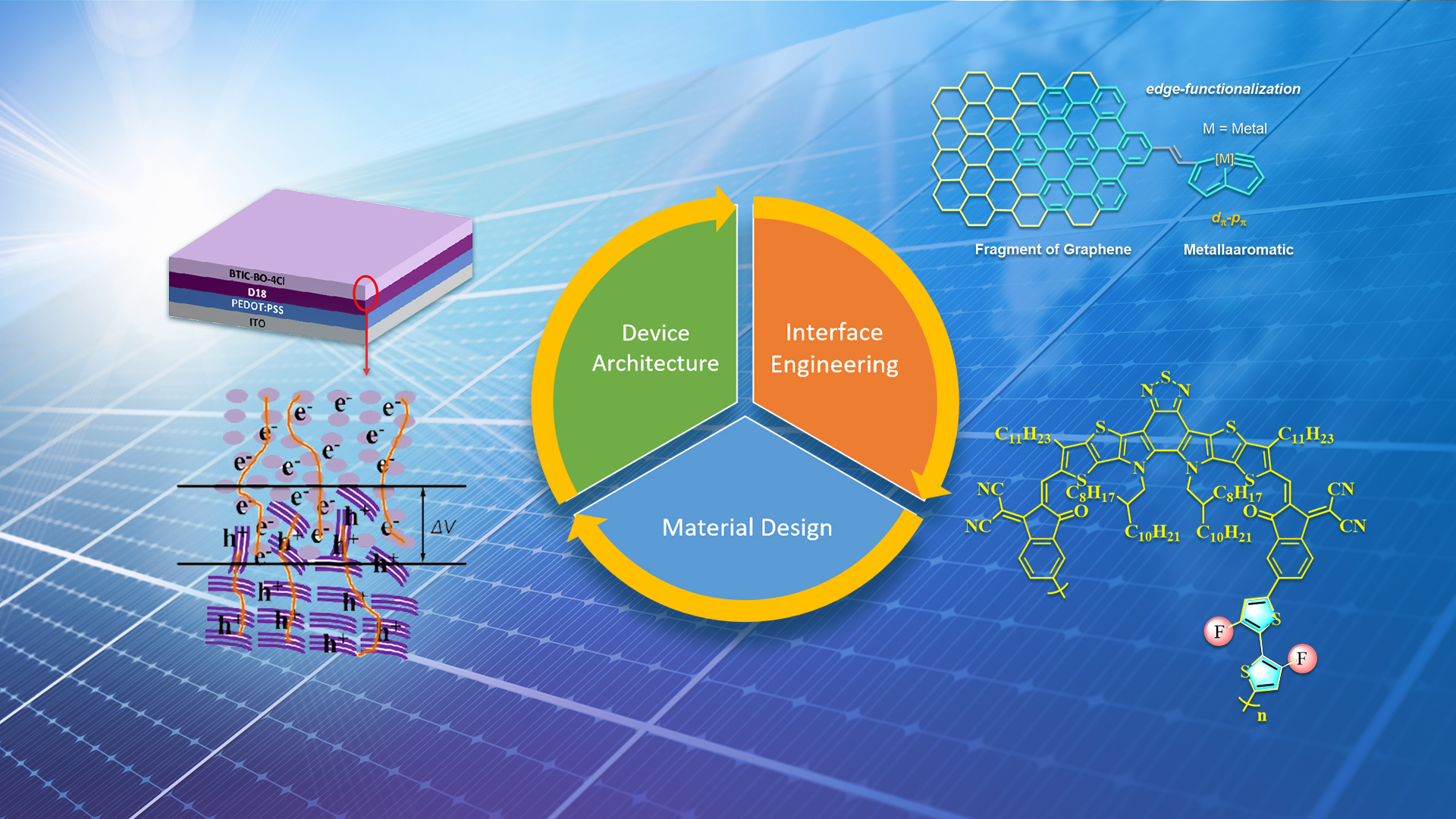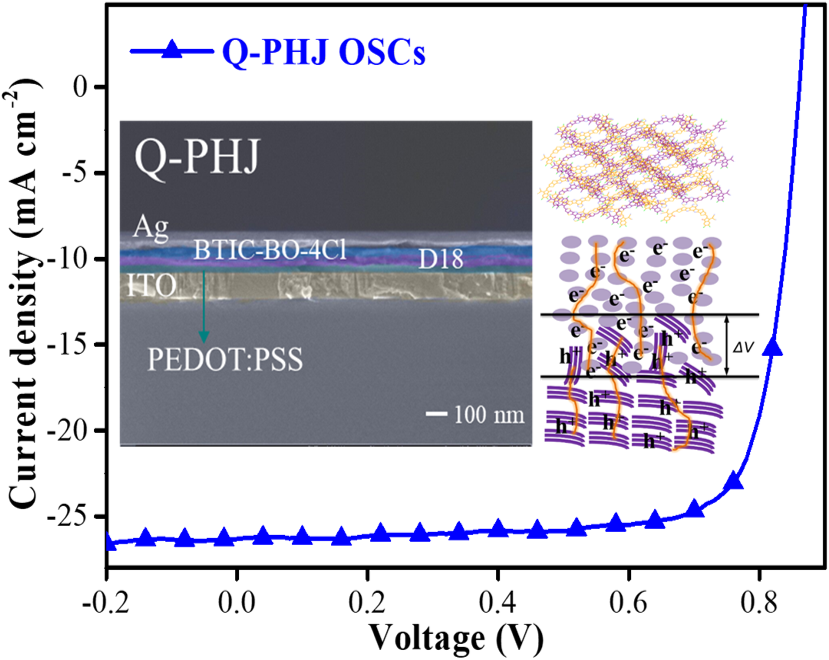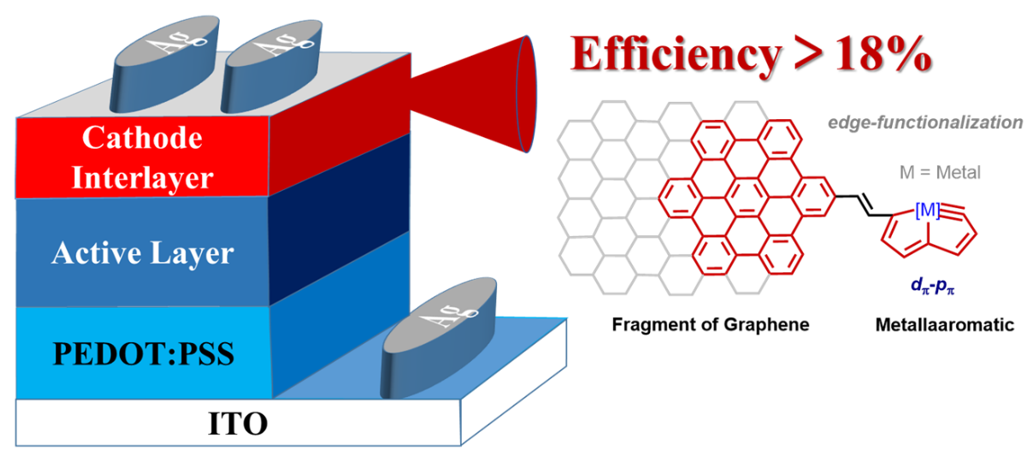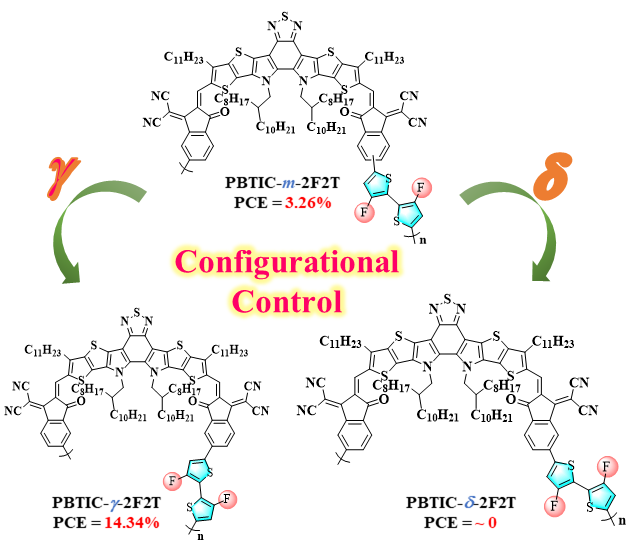Recently, Professor Feng He’s group from the Southern University of Science and Technology (SUSTech) made advances in device architecture, polymer photovoltaic materials, and the interface engineering of Organic Solar Cells (OSCs). Several high-quality papers were published in renowned journals such as Advanced Materials, Advanced Functional Materials, and Joule, boosting the development of OSCs.

Bulk-heterojunction organic solar cells (OSCs) requires both electron donors and acceptors to fabricate the active layer. The photovoltaic performance highly relies on the photophysical properties and miscibility of electron donors and acceptors. In the last several years, the rapid development of non-fullerene electron acceptors, from ITIC to Y6 and its derivatives, has pushed the power conversion efficiency (PCE) of state-of-the-art OSCs higher than 18%. When the miscibility between efficient donor and acceptor was inadequate in some solvents, the bulk heterojunction (BHJ) OSCs based on them had a poor performance. A planar heterojunction (PHJ) structure for the device was proposed to fabricate efficient OSCs.

Figure 1. Schematic diagram of Q-PHJ OSCs
The general PHJ containing donor and acceptor is formed by multiple spin-coating because of the swelling of the solvent and the diffusion of molecules. The tiny nano-scale BHJ region could be produced in PHJ film, therefore defining this structure as quasiplanar heterojunction (Q-PHJ). The efficiency of Q-PHJ OSCs lagged that of BHJ OSCs, but the Q-PHJ OSCs possessed some advantages. The active layer containing donor and acceptor formed an individual bilayer configuration, and the D/A interface produced by the contact between the donor and acceptor can effectively dissociate the excitons. The appearance of non-fullerene 3D interpenetrating network acceptor BTIC-BO-4Cl with long-range exciton diffusion provides a candidate to produce outstanding Q-PHJ OSCs. From the test requirements Q-PHJ OSCs, the D18:BTIC-BO-4Cl based Q-PHJ device has been fabricated, yielding a high power conversion efficiency (PCE) of 17.60%.
This study shows that Q-PHJ architecture can replace BHJarchitecture to realize excellent OSCs for certain unique donors and acceptors, giving an alternative approach for photovoltaic material design and device fabrication. The results, entitled “17.6%-Efficient Quasiplanar Heterojunction Organic Solar Cells from a Chlorinated 3D Network Acceptor,” were published as a research article in the flagship journal Advanced Materials. Research Assistant Professor Hui Chen and Postdoctoral Tingxing Zhao from the Department of Chemistry are the first authors of this work. Postdoctoral Long Li and Assistant Professor Liang Guo from the Department of Mechanical and Energy Engneering were the co-authors. Professor Feng He from the Department of Chemistry and the Shenzhen Grubbs Institute at SUSTech is the corresponding author.

Figure 2. Structure and performance of metal–nanographene-containing large transition metal involving dπ–pπ conjugated systems
In the interface engineering of OSCs, a series of metal–nanographene-containing large transition metal involving dπ–pπ conjugated systems by way of the additional reactions of osmapentalynes and p-diethynyl-hexabenzocoronenes were designed via interdisciplinary and mutual cooperation between two groups. Conjugated extensions are engineered to optimize the π-conjugation of these metal–nanographene molecules, which serve as alcohol-soluble cathode interlayer (CIL) materials. Upon extension of the π-conjugation, the power conversion efficiency (PCE) of PM6:BTP-eC9-based NFSCs increased from 16% to over 18%. This is mainly due to the strong and ordered charge transfer, more matching energy level alignments, better interfacial contacts between the active layer and the electrodes, and regulated morphology. These new CIL materials are broadly able to enhance the photovoltaic properties of OSCs in other systems. A universal application and well-qualified stability could further pave the way toward its satisfactory manufacture, which would promise huge potential for next-generation OSCs.
Their results, entitled “Nanographene–Osmapentalyne Complexes as a Cathode Interlayer in Organic Solar Cells Enhance Efficiency over 18%,” were published as a research article in the flagship journal Advanced Materials. Ph.D. students Longzhu Liu from the Department of Chemistry and Shiyan Chen from Xiamen University are the first authors of this work. Professor Feng He and Haiping Xia from the Department of Chemistry and the Shenzhen Grubbs Institute at SUSTech, alongside Professor Yuanzhi Tan from Xiamen University, are the corresponding authors.

Figure 3. Molecular structure and photovoltaic performance of polymer acceptors
In the design and synthesis of polymer acceptors, the researchers used recrystallization to separate γ-Br-IC or δ-Br-IC in gram scale. They applied the strategy of monomer configurational control in which two isomeric polymeric acceptors (PBTIC-γ-2F2T and PBTIC-δ-2F2T) were produced. As a comparison, PBTIC-m-2F2T from the mixed monomers was also synthesized.
The γ-position based polymer (PBTIC-γ-2F2T) showed good solubility. It achieved the best power conversion efficiency of 14.34% with a high open-circuit voltage of 0.95 V when blended with PM6, which is among the highest values recorded to date. Meanwhile, the δ-position based isomer (PBTIC-δ-2F2T) is insoluble and cannot be processed after parallel polymerization. The mixed-isomers-based polymer, PBTIC-m-2F2T, shows better processing capability but has a low efficiency of 3.26%. Further investigation showed that precise control of configuration helps to improve the regularity of the polymer chain and reduce the π–π stacking distance.
This study demonstrates that configurational control affords a promising strategy to achieve high-performance polymer acceptors. Their results, entitled “Configurational Isomers Induced Significant Difference in All-Polymer Solar Cells” were published as a research article in the flagship journal Advanced Functional Materials. Postdoctoral Hengtao Wang and Research Assistant Professor Hui Chen from the Department of Chemistry are the first authors of this work. Professor Feng He from the Department of Chemistry and the Shenzhen Grubbs Institute at SUSTech is the corresponding author.

Figure 4. The photovoltaic performance of naphthalenothiophene imide polymer donors
Developing novel electron-deficient monomers is crucially important for the future development of non-fullerene organic solar cells. The research team reported a new electron-deficient monomer naphthalenothiophene imide (NTI) and NTI-based copolymers PNTB and PNTB-2T. Polymer chains modify by introducing extra thiophenes result in closed π–π stacking and ordered polymer chain packing of PNTB-2T and is proven to be an effective strategy to increase the device performance. Thus, solar cell devices for PNTB-2T:Y6 exhibit an efficiency of 16.72%, further enhanced to 17.35% by the third component PC71BM, while that for PNTB:Y6 is only 3.81%. Importantly, PNTB-2 T-based devices exhibit excellent batch-to-batch reproducibility. These features make this family of polymer donors very promising, and the design strategies will enlighten the future development of high-performance polymer donors for OSCs.
Their results, entitled “Naphthalenothiophene imide-based polymer exhibiting over 17% efficiency,” were published as a research article in the flagship journal Joule. Master’s students Gongya Zhang and Haijun Ning from Shantou University and Research Assistant Professor Hui Chen from the Department of Chemistry are the first authors of this work. Professor Qinghe Wu from Shantou University and Professor Feng He from the Department of Chemistry and the Shenzhen Grubbs Institute at SUSTech are the corresponding authors.
This study received financial support from the National Natural Science Foundation of China (NSFC), Shenzhen Fundamental Research Program, Guangdong Provincial Key Laboratory of Catalysis, Guangdong Innovative and Entrepreneurial Research Team Program, and the Shenzhen Sci-Tech Fund. It also received practical support from the SUSTech Core Research Facilities for the SEM, AFM, and TEM measurements.
Paper links (In order of appearance above):
Advanced Materials: https://doi.org/10.1002/adma.202102778
Advanced Materials: https://doi.org/10.1002/adma.202101279
Advanced Functional Materials: https://doi.org/10.1002/adfm.202100877
Proofread ByAdrian Cremin, Yingying XIA
Photo By